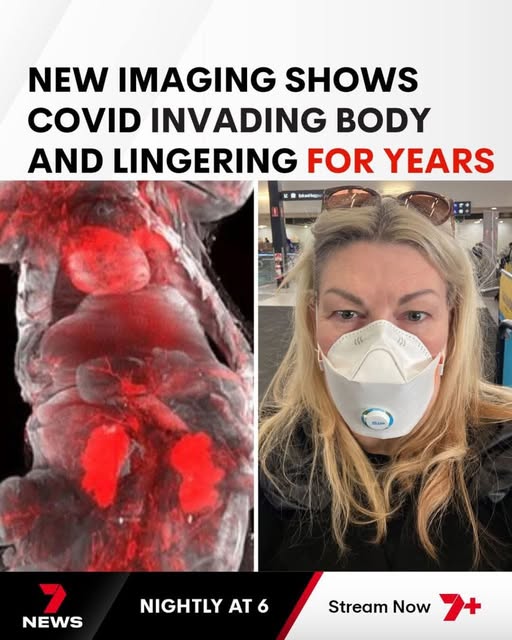A landmark study has found the virus that causes COVID-19 accumulates and persists in the body — especially the brain — for years after infection.
The international team of scientists believe what they have discovered can help explain long COVID.
The research builds on other studies showing the invasiveness of the SARS-CoV-2 virus and the long-term implications.
“Using optical clearing and imaging, we observed the accumulation of SARS-CoV-2 spike protein in the skull-meninges-brain axis of human COVID-19 patients, persisting long after viral clearance,” the study authors reported in leading biomedical journal Cell Host and Microbe.
Meninges are three layers of membranes that cover and protect the brain and spinal cord.
Infectious disease experts in Australia have acclaimed the peer-reviewed study.
Professor Brendan Crabb, Director and CEO of the Burnet Institute for Medical Research and Public Health in Melbourne said the study underlined the need to treat COVID more seriously.

“This work uses cutting edge imaging technology to see things (molecules and cellular structures) to a resolution not achieved before in and around the brains of people infected with SARS-Cov-2 and mice infected with a version of SARS-Cov-2 modified to (infect) mice.
“The virus moves around the body, elegantly confirming what we already know.
“This paper shows that the virus, and especially shed spike protein, can persist around the brain for a long period of time, driving a pathological inflammatory response. This is proposed as a likely cause of the neurological symptoms people with acute and long forms of COVID experience.
“Although not without limitations, this works adds substantially to a large body of work that says COVID enters via the respiratory tract but goes into your bloodstream and so quickly moves around the body accessing many tissues, including the outer regions of the brain.
“Virus in this brain region likely persists and seemingly sheds spike protein which can be further neuro-invasive and persist even longer, (for) years even. This spike persistence is pathological, driving inflammatory responses that have likely consequences for proper brain functioning, such as memory, cognition and neurodegenerative diseases.”
“Next time you think of dismissing COVID as just another annoying common cold it may pay to visualise what you see so starkly in this paper, the virus moving freely around your body and finding a long-term home in all sorts of places where it can really cause trouble, including the brain and the heart,” Prof Crabb, who’s on the board of the WA-based Kids Research Institute Australia, added.
“This work further emphasises the need for individuals, and societies as a whole to take this infection more seriously and try and reduce the amount of transmission using the tools we currently have, most especially vaccination, clean indoor air approaches and well-fitted masks in crowded and poorly ventilated indoor settings.”
“It also showed mRNA spike-based vaccines are protective against spike accumulating in the brain periphery, consistent with what we already know about their protective effect in long COVID.”

Perth long COVID sufferer Melissa Challenor has been sick for two years.
“It’s not getting any better for me,” she said. “People like me are not making shit up. It’s in our brains, it’s in our bodies, it’s in our organs.
“I’m still being seen by the senior neuro physio at Sir Charles Gairdner Hospital who’s been amazing, but now he’s sort of going, ‘Well, where do I refer you? Do I refer you to the Parkinson’s people? Do I refer you to the dementia people?’ Because the neurological symptoms are really quite bad.”
In a commentary published by the Medical Journal of Australia two weeks, researchers from the Burnet Institute said long COVID may be driven by “long infection” and that persistent replicating SARS‐CoV‐2 may be the “unifying driver for long COVID”.
The institute’s Dr Michelle Scoullar said studies had found traces of the virus in many tissues, blood and the gut well after an initial infection.
“We know vaccines can reduce the risk of long COVID, but if the virus continues to be active, antiviral treatments could be a potential treatment for long COVID and might even offer a cure,” she said.
“By prioritising prevention, advancing treatments, and improving access to vaccines, we can take significant steps toward addressing the global challenge of long COVID.”

In the United States, about 5.5 per cent of people infected with COVID experience long-term health effects, including fatigue, muscle pain, and impaired cognitive function.
A recent study demonstrated a lowering of IQ by six points in individuals with long COVID relative to unaffected individuals. Individuals with mild acute infection showed a three‐point drop in IQ.
Children can also get long COVID. A US study in August reported symptoms in 6-to-11 year-olds were different to those for adolescents.
Researchers at the NYU Grossman School of Medicine found that “younger children were more likely to experience a cluster of symptoms relating to stomach and digestive problems, and another characterised by sleep and memory/focus issues, while adolescents had a cluster dominated by change in smell or taste.”
Long COVID also carries an economic burden in terms of lost labour hours. It cost the Australian economy about $9.6 billion in 2022, a study by The Kirby Institute at the University of NSW, reported.



